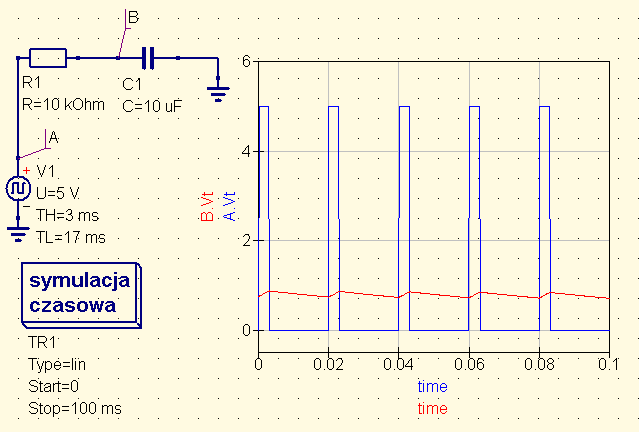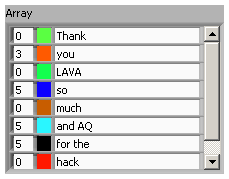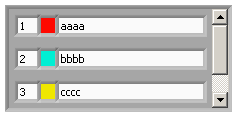-
Posts
393 -
Joined
-
Last visited
-
Days Won
32
Content Type
Profiles
Forums
Downloads
Gallery
Everything posted by vugie
-

diffrent of "property->Value" and "Local Variable"
vugie replied to MViControl's topic in LabVIEW General
So the task for someone skilled (or who wants to be skilled) in XNodes is: create a local variable with error cluster terminals -

Control edition - Which image editor do you use?
vugie replied to Francois Normandin's topic in User Interface
Agreed. But when you want simplicity not sacrificing power I'd say mtPaint (open source) -
In fact there is no difference when used directly after "sizing to fit". But after additional clipping difference is visible:
-
The difference will be clearly visible when you put something into a cluster, set "Size to fit" and then make an array of clusters. It is a difference between 1 px and 2 px element gap.
-

Right-click on LVOOP object wire to Insert Class Methods
vugie replied to Jim Kring's topic in Object-Oriented Programming
Doesn't it apply to project window as well? -
Great. They work in 8.2
-
0 px border would be very hard (if no impossible) to do right-click on it. I think the most optimal solution would be to make such cluster control which clips its content with outside rectangle. Then even thick border made transparent would truly appear as no border (not clipping out controls it overlaps with), still being clickable. Also any border thickness (up to 4) might be applied then by "pasting at same size" any rectangular decoration. AQ: possible?
-
You may build simple circuit of resistor and capacitor, and measure RMS of the signal, which will be proportional to frequency. But as these are rather low frequencies better simulate whole frequency range to tune values of elements (using i.e. Qucs as I did for preliminary study): You may also try (as these are low frequencies) to directly connect the signal to LPT port and catch pin state changes. Single ms resolution should be enough for this. But it depend on minimal pulse width - it cannot be too short.
-
Thanks! It's really cool. Of course LAVA lost the attachment, but I found it posted at OpenG forums: http://forums.openg.org/index.php?showtopic=594&mode=linearplus And here is how the control looks like now:
-
I'm facing similar problem as in this topic. I have a compact cluster of few controls and I would like to get listbox-like behavior with it. The natural way to do it is array of clusters. But even with transparent color the cluster frame still has its 4 px thickness, which makes 8 px gap between elements in array. I can't afford this as my cluster without a frame has 10 px height. Did anyone found any new way to overcome it? I have 8.2 - maybe in newer versions anything has changed at this field? What could be an alternative way to get listbox-like behavior without element gaps? I want to get sth like this (without these gaps): (it is just a sketch - I know that I can remove frame from individual controls, clip them a little, etc. - but still 8 px gap cannot be removed)
-

View Active Topics --- Topic active in last week does not work
vugie replied to dannyt's topic in Site Feedback & Support
Confirm. Even page title is still "Active content in the last 24 hours" (even for the first page). To overcome this, after clicking page number you have to add in the address bar "&period=week" (or weeks, month, months, year). So the whole address would be: http://lavag.org/index.php?app=core&module=search&do=active&search_filter_app[]=1&st=25&period=week Than you can modify displayed page by changing st=25 to something else -

View Unread Content doesn't display threads I replied in?
vugie replied to Yair's topic in Site Feedback & Support
I use it all the time now, and I wish this link to be in the upper right corner instead of *&%$#$%@#$ VUC link. Another advantage of this method is you have not to be logged in to use it (logging in with long e-mail may be painful when using cellphone...) -
Name: Waptia - genetic optimization algorithm Submitter: vugie Submitted: 10 Sep 2009 File Updated: 23 Jan 2011 Category: General LabVIEW Version: 8.2 License Type: BSD (Most common) Waptia - genetic optimization algorithm Copyright © 2009, Wojciech Golebiowski All rights reserved. Author: Wojciech Golebiowski (w_golebiowski (at) tlen.pl) Name: Waptia - genetic optimization algorithm Type: library LabVIEW version: 8.2 Distribution: This code was downloaded from: http://www.lavag.org Description: Waptia is general genetic optimization algorithm - it tries to maximize user supplied function of N variables (so called "Fitness Function"). Function is given as strictly typed VI reference. So the optimization goal may be described as: find such set of N numbers for which Fitness Function value is highest. Waptia is LabVIEW implementation of quite well known genetic optimization algorithm Pikaia by Paul Charbonneau & Barry Knapp developed in Fortran-77. For more information on Pikaia and some background informatio on genetic algorithms visit: http://www.hao.ucar....kaia/pikaia.php Pikaia name comes from lancelet-like creature which lived ages ago in Cambrian sea and waptia was another Cambrian being. Original Pikaia was developed for educational purposes, but it grew up and became widely used routine. Waptia is almost 1:1 conversion of Pikaia code (which is public domain) to LabVIEW - parts of original Fortran code are placed in related VIs - with some cosmetic modifications and improvements. Although Waptia already does real job I treat this code as starting point for further development to create sophisticated, but still easy to use genetic algorithm. Here are Waptia's core features: - decimal genotype encoding - two-point crossover operator - optional dynamically adjustable mutation rate - optional "creep" (smoothly changing) mutation mode - three possible reproduction plans - elitism - optionally stops optimization when fitness criterion is satisfied - optimization progress may be traced on-line with notifiers Usage is very simple - just put Waptia.vi on block diagram and provide number of independent variables and fitness function VI reference (which may be created using included template). There is of course a lot of parameters to tune, but default set usually does good job. Installation Preferably install VIP package with VI Package Manager Alternatively extract ZIP to User.lib. There are no external dependencies. Documentation Documentation is provided in "Waptia docs.rtf" file. It's just a description of all controls of Waptia.vi with some background information. Same information may be found in context help. Information on how to write your own fitness function is provided as comments in "Fitness Function Template.vit" If you want to understand how Waptia works, whole code is extensively commented. Examples There is one quite complex example (but I hope that still understandable) located in _examples folder - "multimodal optimise.vi" If you want any support on general or specifically genetic optimization problems, just contact me. License (BSD): Copyright © 2009 Wojciech Golebiowski All rights reserved. Redistribution and use in source and binary forms, with or without modification, are permitted provided that the following conditions are met: 1. Redistributions of source code must retain the above copyright notice, this list of conditions and the following disclaimer. 2. Redistributions in binary form must reproduce the above copyright notice, this list of conditions and the following disclaimer in the documentation and/or other materials provided with the distribution. 3. The name of the author may not be used to endorse or promote products derived from this software without specific prior written permission. THIS SOFTWARE IS PROVIDED BY THE AUTHOR ``AS IS'' AND ANY EXPRESS OR IMPLIED WARRANTIES, INCLUDING, BUT NOT LIMITED TO, THE IMPLIED WARRANTIES OF MERCHANTABILITY AND FITNESS FOR A PARTICULAR PURPOSE ARE DISCLAIMED. IN NO EVENT SHALL THE AUTHOR BE LIABLE FOR ANY DIRECT, INDIRECT, INCIDENTAL, SPECIAL, EXEMPLARY, OR CONSEQUENTIAL DAMAGES (INCLUDING, BUT NOT LIMITED TO, PROCUREMENT OF SUBSTITUTE GOODS OR SERVICES; LOSS OF USE, DATA, OR PROFITS; OR BUSINESS INTERRUPTION) HOWEVER CAUSED AND ON ANY THEORY OF LIABILITY, WHETHER IN CONTRACT, STRICT LIABILITY, OR TORT (INCLUDING NEGLIGENCE OR OTHERWISE) ARISING IN ANY WAY OUT OF THE USE OF THIS SOFTWARE, EVEN IF ADVISED OF THE POSSIBILITY OF SUCH DAMAGE. Click here to download this file
-
Version 1.0.0
1,845 downloads
Waptia - genetic optimization algorithm Copyright © 2009, Wojciech Golebiowski All rights reserved. Author: Wojciech Golebiowski (w_golebiowski (at) tlen.pl) Name: Waptia - genetic optimization algorithm Type: library LabVIEW version: 8.2 Distribution: This code was downloaded from: http://www.lavag.org Description: Waptia is general genetic optimization algorithm - it tries to maximize user supplied function of N variables (so called "Fitness Function"). Function is given as strictly typed VI reference. So the optimization goal may be described as: find such set of N numbers for which Fitness Function value is highest. Waptia is LabVIEW implementation of quite well known genetic optimization algorithm Pikaia by Paul Charbonneau & Barry Knapp developed in Fortran-77. For more information on Pikaia and some background informatio on genetic algorithms visit: http://www.hao.ucar....kaia/pikaia.php Pikaia name comes from lancelet-like creature which lived ages ago in Cambrian sea and waptia was another Cambrian being. Original Pikaia was developed for educational purposes, but it grew up and became widely used routine. Waptia is almost 1:1 conversion of Pikaia code (which is public domain) to LabVIEW - parts of original Fortran code are placed in related VIs - with some cosmetic modifications and improvements. Although Waptia already does real job I treat this code as starting point for further development to create sophisticated, but still easy to use genetic algorithm. Here are Waptia's core features: - decimal genotype encoding - two-point crossover operator - optional dynamically adjustable mutation rate - optional "creep" (smoothly changing) mutation mode - three possible reproduction plans - elitism - optionally stops optimization when fitness criterion is satisfied - optimization progress may be traced on-line with notifiers Usage is very simple - just put Waptia.vi on block diagram and provide number of independent variables and fitness function VI reference (which may be created using included template). There is of course a lot of parameters to tune, but default set usually does good job. Installation Preferably install VIP package with VI Package Manager Alternatively extract ZIP to User.lib. There are no external dependencies. Documentation Documentation is provided in "Waptia docs.rtf" file. It's just a description of all controls of Waptia.vi with some background information. Same information may be found in context help. Information on how to write your own fitness function is provided as comments in "Fitness Function Template.vit" If you want to understand how Waptia works, whole code is extensively commented. Examples There is one quite complex example (but I hope that still understandable) located in _examples folder - "multimodal optimise.vi" If you want any support on general or specifically genetic optimization problems, just contact me. License (BSD): Copyright © 2009 Wojciech Golebiowski All rights reserved. Redistribution and use in source and binary forms, with or without modification, are permitted provided that the following conditions are met: 1. Redistributions of source code must retain the above copyright notice, this list of conditions and the following disclaimer. 2. Redistributions in binary form must reproduce the above copyright notice, this list of conditions and the following disclaimer in the documentation and/or other materials provided with the distribution. 3. The name of the author may not be used to endorse or promote products derived from this software without specific prior written permission. THIS SOFTWARE IS PROVIDED BY THE AUTHOR ``AS IS'' AND ANY EXPRESS OR IMPLIED WARRANTIES, INCLUDING, BUT NOT LIMITED TO, THE IMPLIED WARRANTIES OF MERCHANTABILITY AND FITNESS FOR A PARTICULAR PURPOSE ARE DISCLAIMED. IN NO EVENT SHALL THE AUTHOR BE LIABLE FOR ANY DIRECT, INDIRECT, INCIDENTAL, SPECIAL, EXEMPLARY, OR CONSEQUENTIAL DAMAGES (INCLUDING, BUT NOT LIMITED TO, PROCUREMENT OF SUBSTITUTE GOODS OR SERVICES; LOSS OF USE, DATA, OR PROFITS; OR BUSINESS INTERRUPTION) HOWEVER CAUSED AND ON ANY THEORY OF LIABILITY, WHETHER IN CONTRACT, STRICT LIABILITY, OR TORT (INCLUDING NEGLIGENCE OR OTHERWISE) ARISING IN ANY WAY OUT OF THE USE OF THIS SOFTWARE, EVEN IF ADVISED OF THE POSSIBILITY OF SUCH DAMAGE. -
I stopped to use "View unread content". Now I use only "View content active for last 24h" (or sth like this). The link is nearly at bottom of main forums page. I remember myself what I read and what I only clicked on. And the period to see may be changed as well. And I'm sure that it won't miss any post.
-
I would gladly see a diode indicating whether termination is proper. I dont't know if it is possible (however I think that EVERYTHING is either possible or expensive), but each time I deal with 485 I have problems with termination. And 5 V output at the end of 6 ft cable is ALWAYS useful...
-
I would vote for LVOOP+Scripting to develop RCF plugin
-
I've tried several ways of typecasting to other classes - nothing worked. Only way I see is to switch frames one by one and OCR frame selector rectangle.
-

VI snippets and security
vugie replied to Rolf Kalbermatter's topic in Application Design & Architecture
The image cluster you get after loading PNG still contains 32-bit image data. All you have to do is to extract from it each fourth byte and it's an alpha channel. Also when you preapare image cluster with such a data PNG will be saved with correct transparency. I don't have LV now to show an example, but check BitMan's (from CR) VI "LV image to Bitmap", "Bitmap to LV image" and "Bitmap to Picture with Alpha" -

VI snippets and security
vugie replied to Rolf Kalbermatter's topic in Application Design & Architecture
You probably know that, but LV PNG functions supports alpha channel for both reading and writing (it is stored within image data). The Picture control uses it, but applies a threshold for alpha to create mask. I wrote a VI (it's included in BitMan) which combines picture with full alpha with part of front panel laying below Picture control in order to simulate full alpha blending with front panel. PS. Your project idea is not clear enough for me... Do you want to create VI back from image for LV<2009? -

Whitepaper on how to write a LabVIEW compatible DLL?
vugie replied to John Lokanis's topic in Calling External Code
rolfk, you should some day go through your posts concerning calling external code and create wiki article from them -

Strange error using serial porta with visa drivers
vugie replied to spaghetti_developer's topic in Hardware
Onece I had an adapter with 2 and 3 pins swapped (Rx and Tx). I'm not 100% sure but as I remember same error appeared. -

Unread content not appearing in the unread list
vugie replied to Yair's topic in Site Feedback & Support
I also ocasionally find never seen posts, when normally using "View unread content". I recently found that on main forums page, nearly at the bottom, there is small, but beautiful link: Today's active content (last 24 hrs) On that list other periods may be selected as well -
I'm not an expert on this topic, just have few thoughts and googled little bit. AFAIK Linux and Solaris are not directly binary compatible, so the only way to run LV natively would be to have sources... just dreaming... but there are some methods to run linux binaries. I have no idea how it would work for runtime engine with all that shared libraries, etc. Another option would be http://www.winehq.org/ - a framework(?), or set of libraries(?) which allow for running Windows program on POSIX systems. Already impressive number of Windows programs are reported to work with Wine so maybe LV RTE will do. The only trials I heard of concerned Development Environment - reported here (6.2 worked 7.0 not). And you have to compile Wine your self (it is doable). There is also commercial fork of Wine - Bordeaux for Solaris ($25). Actually it is for OpenSolaris - I don't know this matters. Next option (and in my opinion most promising) would be Windows (or Linux) virtual machine - clean and small with few shared resources, just for RTE and your application which would run from autostart.
-
I don't know whether word "voop" is not too meaningful...






